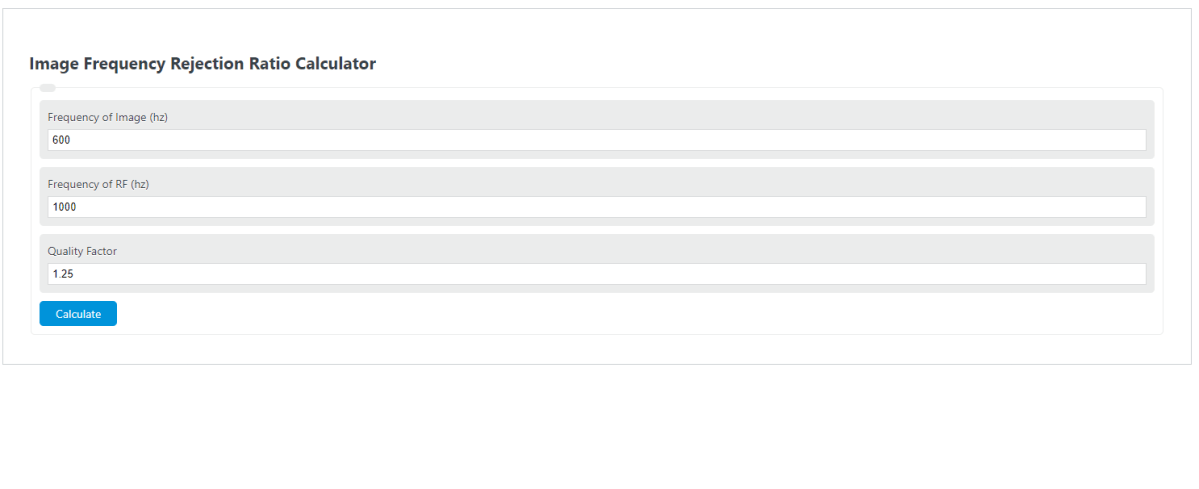Enter the frequency of the image, the frequency of the RF filter, and the quality factor into the calculator to determine the image frequency rejection ratio.
- Q Factor Calculator
- Bandwidth Calculator
- Frequency of Light Calculator
- Aperture Area Calculator
- 95th Percentile Bandwidth Calculator
Image Frequency Rejection Ratio Formula
The following equation is used to calculate the Image Frequency Rejection Ratio.
IFRR = SQRT ( 1 + [(fi/frf)-(frf/fi)]^2*Q^2 )
- Where IFRR is the image frequency rejection ratio
- fi is the frequency of the image (hz)
- frf is the frequency of the RF (hz)
- Q is the quality factor
What is an Image Frequency Rejection Ratio?
Definition:
An image frequency rejection ratio is a metric that measures the performance of a radio receiver.
How to Calculate an Image Frequency Rejection Ratio?
Example Problem:
The following example outlines the steps and information needed to calculate the Image Frequency Rejection Ratio.
First, determine the frequency of the image. In this example, the frequency is 600hz.
Next, determine the frequency of the RF. For this problem, the frequency is 1000hz.
Next, determine the quality factor. The quality factor for this problem is 1.5.
Finally, calculate the image response rejection ratio using the formula above:
IFRR = SQRT ( 1 + [(fi/frf)-(frf/fi)]^2*Q^2 )
IFRR = SQRT ( 1 + [(600/1000)-(1000/600)]^2*1.5^2 )
IFRR = 1886
FAQ
What is the significance of the Quality Factor in calculating the Image Frequency Rejection Ratio?
The Quality Factor (Q) is a dimensionless parameter that measures the selectivity or sharpness of a resonator’s frequency response. In the context of calculating the Image Frequency Rejection Ratio (IFRR), the Q factor represents the resonator’s (often an RF filter in this case) ability to discriminate between the desired signal frequency and the image frequency. A higher Q factor indicates a narrower bandwidth, which enhances the rejection of the image frequency, improving the receiver’s performance.
How does the frequency of the image and the RF frequency affect the Image Frequency Rejection Ratio?
The frequencies of the image (fi) and the RF (frf) are crucial in determining the IFRR because they directly influence the difference and ratio between the image frequency and the RF frequency, as seen in the formula. The closer these two frequencies are, the more challenging it becomes to filter out the image without affecting the desired signal, potentially lowering the IFRR. The formula accounts for this by including the difference and ratio between fi and frf, which impacts the overall calculation of the IFRR.
Can the Image Frequency Rejection Ratio be improved and, if so, how?
Yes, the Image Frequency Rejection Ratio can be improved by several methods. One approach is to increase the Quality Factor (Q) of the RF filter, which can be achieved by using higher quality components or design techniques that narrow the filter’s bandwidth without degrading its insertion loss. Another method is to carefully select the RF frequency (frf) and the local oscillator frequency to maximize the separation between the desired frequency and the image frequency, thereby making it easier to achieve effective rejection. Additionally, advanced filtering techniques and technologies can also contribute to a higher IFRR, enhancing the overall performance of the radio receiver.
